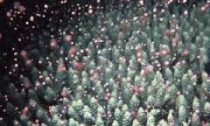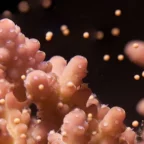
It’s one of the most spectacular natural phenomena on Earth, and it only happens once a year – the annual mass spawning event at the Great Barrier Reef. Also known as the Great Barrier Reef’s ‘annual sex festival’, the event sees corals from all over the reef releasing their sperm and eggs into the water at the same time – and they appear to coordinate the whole event based on the full moon.
“The big days are after the full moon in November,” marine biologist Richard Fitzpatrick from James Cook University in Australia told The Huffington Post.
“On the third day after the full moon, you’ll get the staghorn corals spawning, but the really big night is usually five days after the moon. That’s when you get the big plate corals spawning and a lot of other corals.”
According to the BBC, at 7:30pm local time on November 21, the 2016 mass spawning event kicked off, and it can last days or even a week after the initial burst of activity – but only at night when predation is low.
If you’re lucky enough to be exploring the Great Barrier Reef during their long-awaited sex festival (or unlucky, depending on how you feel about coral sperm), you’ll experience an eerie underwater ‘snowstorm’, as thousands and thousands of colonies release their gametes into the ocean:
“You can feel it. You run your fingers through the water and feel the eggs as they’re going up,” underwater photographer Stuart Ireland told Australian Geographic.
“It’s a little like if you’re driving slowly in the rain, and you put your head out the window and feel the little droplets on your face. It’s a strange feel[ing].”
The reason these corals coordinate like this every year is that with everybody spurting eggs and sperm into the water at the same time, the chances of their sex cells finding a match are much higher than if they just threw their seed out at random times.
Being immobile, coral can find it difficult to reproduce, because they can’t travel through the ocean in search of a suitable mate. Instead, they prepare tiny polyps – little packages containing either eggs or sperm – and release them into the water to drift to the surface, pop, and form a spawn ‘soup’.
If eggs and sperm in this soup combine, they can travel on the waves to form new colonies in areas of the reef far from their parent corals.
In the Great Barrier reef, this annual event can sometimes be split into two stages, because seeing as the reef is larger than the entire country of Italy, there’s a whole lot of ground to make up.
Often, the colonies in the centre of the reef will start their spawning in October or November, and the colonies on the outer edges will follow suit a month or so afterwards.
But regardless of when each area of the reef kicks off their annual sex festival, it’s always dictated by the full moon.
Back in 2007, a study confirmed that corals can tell when the moon is full, thanks to an ancient gene that allows them to sense how much moonlight is hitting the water.
“This is the key to one of the central mysteries of coral reefs,” one of the team, Ove Hoegh-Guldberg from the University of Queensland, said at the time. “We have always wondered how corals without eyes can detect moonlight and get the precise hour of the right couple of days each year to spawn.”
Scientists had assumed that corals were timing their annual sex festival with the moon’s phases because of how the moon influenced the tides.
But when they actually investigated this hypothesis, they found that the tides were all over the place during the event – in some places they were high, in others they were low, suggesting that the reef wasn’t coordinating to take advantage of an idea tide.
Instead, researchers now suspect that the full moon is simply the best marker the corals can all detect – the brightest moon is the brightest beacon, and could simply be the best visual cue the corals have for synchronised sex.
Only time will tell if this year’s mating bonanza will have a positive effect on the Great Barrier Reef, after it’s had such a crappy 2016, but it’s a hell of way to close out the year.














Social Profiles